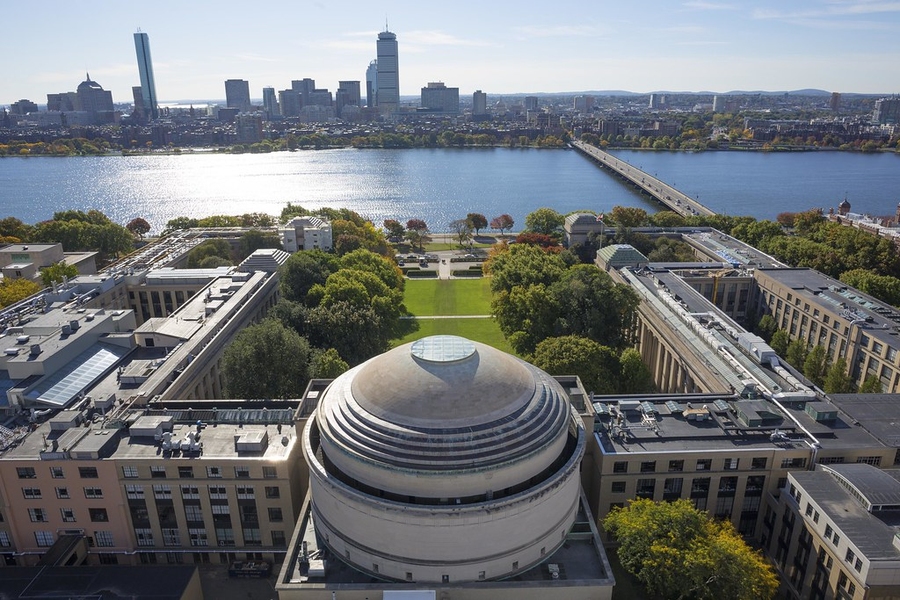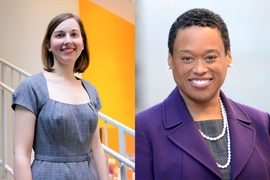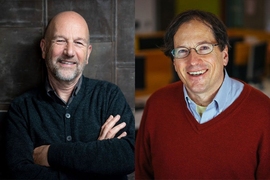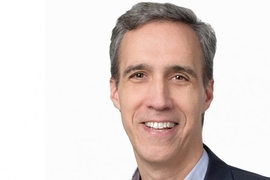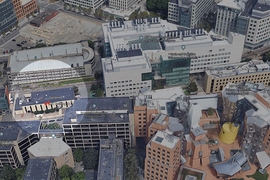Nearly every aspect of the modern world is being transformed by computing. As computing technology continues to revolutionize the way people live, work, learn, and interact, computing research and education are increasingly playing a role in a broad range of academic disciplines, and are in turn being shaped by this expanding breadth.
To connect computing and other disciplines in addressing critical challenges and opportunities facing the world today, the MIT Stephen A. Schwarzman College of Computing is planning to create 25 new faculty positions that will be shared between the college and an MIT department or school. Hiring for these new positions will be focused on six strategic areas of inquiry, to build capacity at MIT in key computing domains that cut across departments and schools. The shared faculty members are expected to engage in research and teaching that contributes to their home department, that is of mutual value to that department and the college, and that helps form and strengthen cross-departmental ties.
“These new shared faculty positions present an unprecedented opportunity to develop crucial areas at MIT which connect computing with other disciplines,” says Daniel Huttenlocher, dean of the MIT Schwarzman College of Computing. “By coordinated hiring between the college and departments and schools, we expect to have significant impact with multiple touch points across MIT.”
The six strategic areas and the schools expected to be involved in hiring for each are as follows:
Social, Economic, and Ethical Implications of Computing and Networks. Associated schools: School of Humanities, Arts and the Social Sciences and MIT Sloan School of Management.
There have been tremendous advances in new digital platforms and algorithms, which have already transformed our economic, social, and even political lives. But the future societal implications of these technologies and the consequences of the use and misuse of massive social data are poorly understood. There are exciting opportunities for building on the growing intellectual connections between computer science, data science, and social science and humanities, in order to bring a better conceptual framework to understand the social and economic implications, ethical dimensions, and regulation of these technologies.
Focusing on the interplay between computing systems and our understanding of individuals and societal institutions, this strategic hiring area will include faculty whose work focuses on the broader consequences of the changing digital and information environment, market design, digital commerce and competition, and economic and social networks. Issues of interest include how computing and AI technologies have shaped and are shaping the work of the future; how social media tools have reshaped political campaigns, changed the nature and organization of mass protests, and spurred governments to either reduce or dramatically enhance censorship and social control; increasing challenges in adjudicating what information is reliable, what is slanted, and what is entirely fake; conceptions of privacy, fairness, and transparency of algorithms; and the effects of new technologies on democratic governance.
Computing and Natural Intelligence: Cognition, Perception, and Language. Associated schools: School of Science; School of Humanities, Arts, and Social Sciences; and School of Architecture and Planning.
Intelligence — what it is, how the brain produces it, and how it can be engineered — is simultaneously one of the greatest open questions in natural sciences and the most important engineering challenges of our time. Significant advances in computing and machine learning have enabled a better understanding of the brain and the mind. Concurrently, neuroscience and cognitive science have started to give meaningful engineering guidance to AI and related computing efforts. Yet, huge gaps remain in connecting the science and engineering of intelligence.
Integrating science, computing, and social sciences and humanities, this strategic hiring area aims to address the gap between science and engineering of intelligence, in order to make transformative advances in AI and deepen our understanding of natural intelligence. Hiring in this area is expected to advance a holistic approach to understanding human perception and cognition through work such as the study of computational properties of language by bridging linguistic theory, cognitive science, and computer science; improving the art of listening by re-engineering music through music classification and machine learning, music cognition, and new interfaces for musical expression; discovering how artificial systems might help explain natural intelligence and vice versa; and seeking ways in which computing can aid in human expression, communications, health, and meaning.
Computing in Health and Life Sciences. Associated schools: School of Engineering; School of Science; and MIT Sloan School of Management.
Computing is increasingly becoming an indispensable tool in the health and life sciences. A key area is facilitating new approaches to identifying molecular and biomolecular agents with desired functions and for discovering new medications and new means of diagnosis. For instance, machine learning provides a unique opportunity in the pursuit of molecular and biomolecular discovery to parameterize and augment physics-based models, or possibly even replace them, and enable a revolution in molecular science and engineering. Another major area is health-care delivery, where novel algorithms, high performance computing, and machine learning offer new possibilities to transform health monitoring and treatment planning, facilitating better patient care, and enabling more effective ways to help prevent disease. In diagnosis, machine learning methods hold the promise of improved detection of diseases, increasing both specificity and sensitivity of imaging and testing.
This strategic area aims to hire faculty who help create transformative new computational methods in health and life sciences, while complementing the considerable existing work at MIT by forging additional connections. The broad scope ranges from computational approaches to fundamental problems in molecular design and synthesis for human health; to reshaping health-care delivery and personalized medicine; to understanding radiation effects and optimizing dose delivery on target cells; to improving tracing, imaging, and diagnosis techniques.
Computing for Health of the Planet. Associated schools: School of Engineering; School of Science; and School of Architecture and Planning.
The health of the planet is one of the most important challenges facing humankind today. Rapid industrialization has led to a number of serious threats to human and ecosystem health, including climate change, unsafe levels of air and water pollution, coastal and agricultural land erosion, and many others. Ensuring the health and safety of our planet necessitates an interdisciplinary approach that connects scientific understanding, engineering solutions, social, economic, and political aspects, with new computational methods to provide data-driven models and solutions for providing clean air, usable water, resilient food, efficient transportation systems, and identifying sustainable sources of energy.
This strategic hiring area will help facilitate such collaborations by bringing together expertise that will enable us to advance physical understanding of low-carbon energy solutions, earth-climate modelling, and urban planning through high performance computing, transformational numerical methods, and/or machine learning techniques.
Computing and Human Experience. Associated schools: School of Humanities, Arts, and Social Sciences and School of Architecture and Planning.
Computing and digital technologies are challenging the very ways in which people understand reality and our role in it. These technologies are embedded in the everyday lives of people around the world, and while frequently highly useful, they can reflect cultural assumptions and technological heritage, even though they are often viewed as being neutral prescriptions for structuring the world. Indeed, as becomes increasingly apparent, these technologies are able to alter individual and societal perceptions and actions, or affect societal institutions, in ways that are not broadly understood or intended. Moreover, although these technologies are conventionally developed for improved efficacy or efficiency, they can also provide opportunities for less utilitarian purposes such as supporting introspection and personal reflection.
This strategic hiring area focuses on growing the set of scholars in the social sciences, humanities, and computing who examine technology designs, systems, policies, and practices that can address the dual challenges of the lack of understanding of these technologies and their implications, including the design of systems that may help ameliorate rather than exacerbate inequalities. It further aims to develop techniques and systems that help people interpret and gain understanding from societal and historical data, including in humanities disciplines such as comparative literature, history, and art and architectural history.
Quantum Computing. Associated schools: School of Engineering and School of Science.
One of the most promising directions for continuing improvements in computing power comes from quantum mechanics. In the coming years, new hardware, algorithms, and discoveries offer the potential to dramatically increase the power of quantum computers far beyond current machines. Achieving these advances poses challenges that span multiple scientific and engineering fields, and from quantum hardware to quantum computing algorithms. Potential quantum computing applications span a broad range of fields, including chemistry, biology, materials science, atmospheric modeling, urban system simulation, nuclear engineering, finance, optimization, and others, requiring a deep understanding of both quantum computing algorithms and the problem space.
This strategic hiring area aims to build on MIT’s rich set of activities in the space to catalyze research and education in quantum computing and quantum information across the Institute, including the study of quantum materials; developing robust controllable quantum devices and networks that can faithfully transmit quantum information; and new algorithms for machine learning, AI, optimization, and data processing to fully leverage the promise of quantum computing.
A coordinated approach
Over the past few months, the MIT Schwarzman College of Computing has undertaken a strategic planning exercise to identify key areas for hiring the new shared faculty. The process has been led by Huttenlocher, together with MIT Provost Martin Schmidt and the deans of the five schools — Anantha Chandrakasan, dean of the School of Engineering; Melissa Nobles, Kenan Sahin Dean of the School of Humanities, Arts, and Social Sciences; Hashim Sarkis, dean of the School of Architecture and Planning; David Schmittlein, John C. Head III Dean of MIT Sloan; and Michael Sipser, dean of the School of Science — beginning with input from departments across the Institute.
This input was in the form of proposals for interdisciplinary computing areas that were solicited from department heads. A total of 29 proposals were received. Over a six-week period, the committee worked with proposing departments to identify strategic hiring themes. The process yielded the six areas that cover several critically important directions.
“These areas not only bring together computing with numerous departments and schools, but also involve multiple modes of academic inquiry, offering opportunities for new collaborations in research and teaching across a broad range of fields,” says Schmidt. “I’m excited to see us launch this critical part of the college’s mission.”
The college will also coordinate with each of the five schools to ensure that diversity, equity, and inclusion is at the forefront for all of the hiring areas.
Hiring for the 2020-21 academic year
While the number of searches and involved schools will vary from year to year, the plan for the coming academic year is to have five searches, one with each school. These searches will be in three of the six strategic hiring areas as follows:
Social, Economic, and Ethical Implications of Computing and Networks will focus on two searches, one with the Department of Philosophy in the School of Humanities, Arts, and Social Sciences, and one with the MIT Sloan School of Management.
Computing and Natural Intelligence: Cognition, Perception and Language will focus on one search with the Department of Brain and Cognitive Sciences in the School of Science.
Computing for Health of the Planet will focus on two searches, one with the Department of Urban Studies and Planning in the School of Architecture and Planning, and one with a department to be identified in the School of Engineering.
